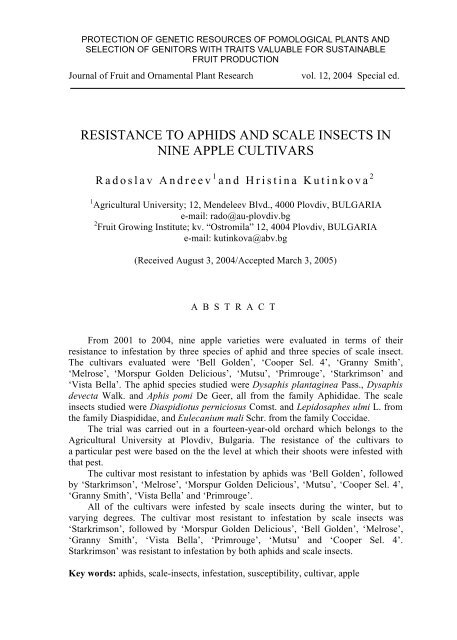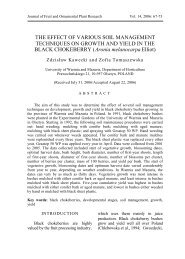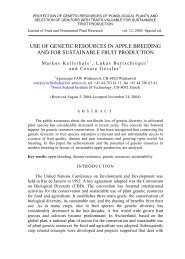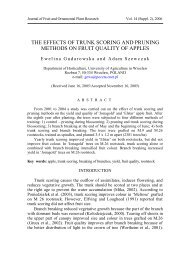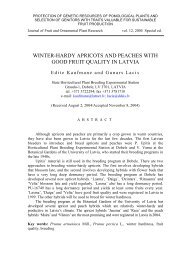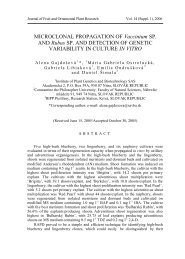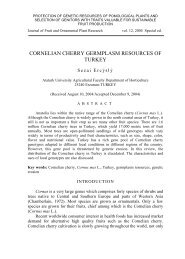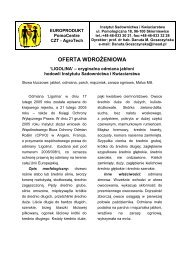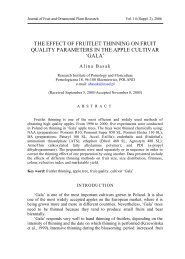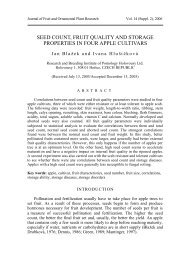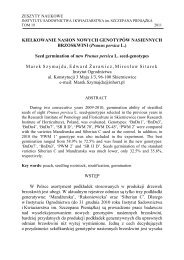Resistance to aphids and scale insects in nine apple cultivars
Resistance to aphids and scale insects in nine apple cultivars
Resistance to aphids and scale insects in nine apple cultivars
You also want an ePaper? Increase the reach of your titles
YUMPU automatically turns print PDFs into web optimized ePapers that Google loves.
PROTECTION OF GENETIC RESOURCES OF POMOLOGICAL PLANTS AND<br />
SELECTION OF GENITORS WITH TRAITS VALUABLE FOR SUSTAINABLE<br />
FRUIT PRODUCTION<br />
Journal of Fruit <strong>and</strong> Ornamental Plant Research<br />
vol. 12, 2004 Special ed.<br />
RESISTANCE TO APHIDS AND SCALE INSECTS IN<br />
NINE APPLE CULTIVARS<br />
Radoslav Andreev 1 <strong>and</strong> Hrist<strong>in</strong>a Kut<strong>in</strong>kova 2<br />
1 Agricultural University; 12, Mendeleev Blvd., 4000 Plovdiv, BULGARIA<br />
email: rado@auplovdiv.bg<br />
2 Fruit Grow<strong>in</strong>g Institute; kv. “Ostromila” 12, 4004 Plovdiv, BULGARIA<br />
email: kut<strong>in</strong>kova@abv.bg<br />
(Received August 3, 2004/Accepted March 3, 2005)<br />
ABSTRACT<br />
From 2001 <strong>to</strong> 2004, n<strong>in</strong>e <strong>apple</strong> varieties were evaluated <strong>in</strong> terms of their<br />
resistance <strong>to</strong> <strong>in</strong>festation by three species of aphid <strong>and</strong> three species of <strong>scale</strong> <strong>in</strong>sect.<br />
The <strong>cultivars</strong> evaluated were ‘Bell Golden’, ‘Cooper Sel. 4’, ‘Granny Smith’,<br />
‘Melrose’, ‘Morspur Golden Delicious’, ‘Mutsu’, ‘Primrouge’, ‘Starkrimson’ <strong>and</strong><br />
‘Vista Bella’. The aphid species studied were Dysaphis plantag<strong>in</strong>ea Pass., Dysaphis<br />
devecta Walk. <strong>and</strong> Aphis pomi De Geer, all from the family Aphididae. The <strong>scale</strong><br />
<strong><strong>in</strong>sects</strong> studied were Diaspidiotus perniciosus Comst. <strong>and</strong> Lepidosaphes ulmi L. from<br />
the family Diaspididae, <strong>and</strong> Eulecanium mali Schr. from the family Coccidae.<br />
The trial was carried out <strong>in</strong> a fourteenyearold orchard which belongs <strong>to</strong> the<br />
Agricultural University at Plovdiv, Bulgaria. The resistance of the <strong>cultivars</strong> <strong>to</strong><br />
a particular pest were based on the the level at which their shoots were <strong>in</strong>fested with<br />
that pest.<br />
The cultivar most resistant <strong>to</strong> <strong>in</strong>festation by <strong>aphids</strong> was ‘Bell Golden’, followed<br />
by ‘Starkrimson’, ‘Melrose’, ‘Morspur Golden Delicious’, ‘Mutsu’, ‘Cooper Sel. 4’,<br />
‘Granny Smith’, ‘Vista Bella’ <strong>and</strong> ‘Primrouge’.<br />
All of the <strong>cultivars</strong> were <strong>in</strong>fested by <strong>scale</strong> <strong><strong>in</strong>sects</strong> dur<strong>in</strong>g the w<strong>in</strong>ter, but <strong>to</strong><br />
vary<strong>in</strong>g degrees. The cultivar most resistant <strong>to</strong> <strong>in</strong>festation by <strong>scale</strong> <strong><strong>in</strong>sects</strong> was<br />
‘Starkrimson’, followed by ‘Morspur Golden Delicious’, ‘Bell Golden’, ‘Melrose’,<br />
‘Granny Smith’, ‘Vista Bella’, ‘Primrouge’, ‘Mutsu’ <strong>and</strong> ‘Cooper Sel. 4’.<br />
Starkrimson’ was resistant <strong>to</strong> <strong>in</strong>festation by both <strong>aphids</strong> <strong>and</strong> <strong>scale</strong> <strong><strong>in</strong>sects</strong>.<br />
Key words: <strong>aphids</strong>, <strong>scale</strong><strong><strong>in</strong>sects</strong>, <strong>in</strong>festation, susceptibility, cultivar, <strong>apple</strong>
R. Andreev <strong>and</strong> H. Kut<strong>in</strong>kova<br />
INTRODUCTION<br />
To ensure a high quality crop, <strong>apple</strong> orchards need <strong>to</strong> be sprayed with<br />
pesticides from ten <strong>to</strong> fifteen times a season. This is costly <strong>and</strong> harmful <strong>to</strong> the<br />
environment. Therefore, a lot of research has recently been directed <strong>to</strong>ward<br />
develop<strong>in</strong>g ways <strong>to</strong> reduce the amount of chemicals used <strong>in</strong> commercial<br />
orchards.<br />
One of the most promis<strong>in</strong>g ways <strong>to</strong> reduce chemical use is breed<strong>in</strong>g<br />
<strong>cultivars</strong> which are resistant or <strong>to</strong>lerant <strong>to</strong> pests <strong>and</strong> diseases. This approach<br />
has already had significant success. There are now several new <strong>apple</strong> <strong>cultivars</strong><br />
which are resistant <strong>to</strong> economically important diseases such as <strong>apple</strong> scab <strong>and</strong><br />
powdery mildew (Pedersen et al. 1994; Nakov et al., 1999). There has been<br />
less progress <strong>in</strong> develop<strong>in</strong>g <strong>cultivars</strong> resistant <strong>to</strong> <strong>in</strong>sect <strong>and</strong> arthropod pests,<br />
though <strong>in</strong>tensive research has been carried out, especially on <strong>cultivars</strong><br />
resistant <strong>to</strong> suck<strong>in</strong>g pests such as <strong>aphids</strong> <strong>and</strong> mites (Habekuss et al., 2000).<br />
In one study, the <strong>cultivars</strong> ‘Flor<strong>in</strong>a’ <strong>and</strong> ‘Fiesta’ were found <strong>to</strong> be<br />
resistant <strong>to</strong> Dysaphis plantag<strong>in</strong>ea Pass. (RatMorris, 1993; RatMorris <strong>and</strong><br />
Lesp<strong>in</strong>asse, 1995) In another study, young <strong>apple</strong> trees grafted on three<br />
different roots<strong>to</strong>cks were evaluated <strong>in</strong> terms of their resistance <strong>to</strong> Dysaphis<br />
plantag<strong>in</strong>ea <strong>and</strong> Aphis pomi De Geer (Sacco <strong>and</strong> DallaMonta, 1994). In yet<br />
another study, <strong>apple</strong> <strong>cultivars</strong> were were evaluated <strong>in</strong> terms of their resistance<br />
<strong>to</strong> the woolly aphid, Eriosoma lanigerum Hausm. (Asante, 1994). In Quebec,<br />
Canada, thirtytwo <strong>apple</strong> roots<strong>to</strong>cks resistant <strong>to</strong> the wooly aphid were selected<br />
<strong>in</strong> (Khanizadeh et al., 2000). There has been considerable progress <strong>in</strong><br />
develop<strong>in</strong>g <strong>apple</strong> <strong>cultivars</strong> resistant <strong>to</strong> the codl<strong>in</strong>g moth, Cydia pomonella L.<br />
(D<strong>and</strong>ekar et al., 1994; Clark et al., 2004). In several countries, programs have<br />
been established for breed<strong>in</strong>g <strong>cultivars</strong> resistant <strong>to</strong> pests <strong>and</strong> diseases<br />
(Labuschagne <strong>and</strong> Schmidt, 1999; Bus et al., 2000; Ballard, 2002). Molecular<br />
<strong>and</strong> genetic studies on pest <strong>and</strong> disease resistance are also underway (Roche et<br />
al., 1997; Cevik <strong>and</strong> K<strong>in</strong>g, 2000).<br />
The aim of this study was <strong>to</strong> evaluate n<strong>in</strong>e <strong>apple</strong> <strong>cultivars</strong> <strong>in</strong> terms of<br />
their resistance <strong>to</strong> <strong>aphids</strong> <strong>and</strong> <strong>scale</strong> <strong><strong>in</strong>sects</strong> <strong>in</strong> order <strong>to</strong> select the <strong>cultivars</strong> that<br />
should be used <strong>in</strong> future breed<strong>in</strong>g programs.<br />
MATERIAL AND METHODS<br />
From 2001 <strong>to</strong> 2004, n<strong>in</strong>e <strong>apple</strong> varieties were evaluated <strong>in</strong> terms of their<br />
resistance <strong>to</strong> <strong>in</strong>festation by three species of aphid <strong>and</strong> three species of <strong>scale</strong><br />
<strong>in</strong>sect. The <strong>cultivars</strong> evaluated were ‘Bell Golden’, ‘Cooper Sel. 4’, ‘Granny<br />
Smith’, ‘Melrose’, ‘Morspur Golden Delicious’, ‘Mutsu’, ‘Primrouge’,<br />
‘Starkrimson’ <strong>and</strong> ‘Vista Bella’.<br />
216<br />
J. Fruit Ornam. Plant Res. Special ed. vol. 12, 2004: 215221
<strong>Resistance</strong> <strong>to</strong> <strong>aphids</strong> <strong>and</strong> <strong>scale</strong> <strong><strong>in</strong>sects</strong> <strong>in</strong>…..<strong>apple</strong> cvs<br />
The aphid species studied were the rosy <strong>apple</strong> aphid (Dysaphis<br />
plantag<strong>in</strong>ea Pass.), the rosy leafcurl<strong>in</strong>g aphid (Dysaphis devecta Walk.), <strong>and</strong><br />
the green <strong>apple</strong> aphid (Aphis pomi De Geer), all from the family Aphididae.<br />
The <strong>scale</strong> <strong>in</strong>sect species studied were San Jose <strong>scale</strong> (Diaspidiotus<br />
perniciosus Comst.) <strong>and</strong> oystershell <strong>scale</strong> (Lepidosaphes ulmi L.) from the<br />
family Diaspididae, <strong>and</strong> Eulecanium mali Schr. from the family Coccidae.<br />
Twenty <strong>to</strong> thirty trees of each cultivar were planted <strong>in</strong> a fourteenyearold<br />
orchard which belongs <strong>to</strong> the Agricultural University at Plovdiv, Bulgaria. No<br />
pesticides were applied. The resistance of the <strong>cultivars</strong> <strong>to</strong> a particular pest<br />
were based on the the level at which their shoots were <strong>in</strong>fested with that pest.<br />
Infestation by <strong>aphids</strong> was recorded <strong>in</strong> the second half of May, when aphid<br />
colonies are most abundant. In 2001 <strong>and</strong> 2002, all aphid species were<br />
recorded <strong>to</strong>gether. In 2003 <strong>and</strong> 2004, <strong>in</strong>dividual species were recorded<br />
separately. Infestation was graded accord<strong>in</strong>g <strong>to</strong> the follow<strong>in</strong>g scheme:<br />
Level of <strong>in</strong>festation<br />
Percentage of <strong>in</strong>fested<br />
shoots<br />
Score<br />
No <strong>in</strong>festation No <strong>aphids</strong> seen 0<br />
Slight 0 <strong>to</strong> 5% *<br />
Moderate 5 <strong>to</strong> 15% **<br />
High 15 <strong>to</strong> 50% ***<br />
Severe over 50% ****<br />
Infestation by the <strong>scale</strong> <strong><strong>in</strong>sects</strong> was recorded <strong>in</strong> the w<strong>in</strong>ter of 2003/2004.<br />
Two shoots were collected from each tree of each cultivar <strong>and</strong> cut <strong>in</strong><strong>to</strong> 10 cm<br />
sections. Sixty <strong>to</strong> eighty 10 cm sections were exam<strong>in</strong>ed for each cultivar. The<br />
mean <strong>to</strong>tal number of <strong>scale</strong> <strong><strong>in</strong>sects</strong> per section <strong>and</strong> the mean number of liv<strong>in</strong>g<br />
<strong>scale</strong> <strong><strong>in</strong>sects</strong> per section were recorded for each cultivar.<br />
RESULTS AND DISCUSSION<br />
Aphids were most abundant <strong>in</strong> May <strong>and</strong> early June (Tab. 1). The most<br />
abundant aphid species was Dysaphis plantag<strong>in</strong>ea. The only cultivar not<br />
<strong>in</strong>fested by D. plantag<strong>in</strong>ea was ‘Bell Golden’. The <strong>cultivars</strong> least resistant <strong>to</strong><br />
D. plantag<strong>in</strong>ea were ‘Granny Smith’ <strong>and</strong> ‘Primrouge’.<br />
The next most abundant aphid species was Dysaphis devecta, which<br />
<strong>in</strong>fested relatively more trees <strong>in</strong> 2004 than <strong>in</strong> 2003. This may be because 2004<br />
was a ra<strong>in</strong>y year. The <strong>cultivars</strong> which were not <strong>in</strong>fested at all by D. devecta<br />
J. Fruit Ornam. Plant Res. Special ed. vol. 12, 2004: 215221 217
R. Andreev <strong>and</strong> H. Kut<strong>in</strong>kova<br />
were ‘Bell Golden’, ‘Granny Smith’, ‘Matsu’ <strong>and</strong> ‘Starkrimson’. The cultivar<br />
least resistant <strong>to</strong> D. devecta was ‘Primrouge’.<br />
Table 1. Infestation by three species of aphid <strong>in</strong> n<strong>in</strong>e <strong>apple</strong> <strong>cultivars</strong>. Plovdiv<br />
region, 2001 <strong>to</strong> 2003<br />
Cultivar<br />
All species<br />
Dysaphis<br />
plantag<strong>in</strong>ea<br />
Dysaphis<br />
devecta<br />
Aphis pomi<br />
2001 2002 2003 2004 2003 2004 2003 2004<br />
Total<br />
stars for<br />
all years<br />
2001<br />
2004<br />
‘Bell Golden’ 0 0 0 0 0 0 0 ** 2<br />
‘Cooper Sel. 4’ ** * * ** 0 ** 0 0 8<br />
‘Granny Smith’ *** ** *** *** 0 0 0 0 11<br />
‘Melrose’ * * ** ** 0 * 0 0 7<br />
‘Morspur Gol.<br />
Del’<br />
* * * ** 0 ** 0 0 7<br />
‘Mutsu’ * 0 * *** 0 0 ** 0 7<br />
‘Primrouge’ ** ** ** *** * ** ** * 15<br />
‘Starkrimson’ 0 0 * ** 0 0 0 0 3<br />
‘Vista Bella’ ** * * ** * * * ** 11<br />
0 – no <strong>aphids</strong> * – slight <strong>in</strong>festation ** – moderate <strong>in</strong>festation<br />
*** – high <strong>in</strong>festation **** – severe <strong>in</strong>festation<br />
The least abundant of the three aphid species was Aphis pomi, which was<br />
found only on trees not <strong>in</strong>fested by D. plantag<strong>in</strong>ea. This suggests that there is<br />
an antagonistic relationship between D. plantag<strong>in</strong>ea <strong>and</strong> A. pomi, <strong>in</strong> which D.<br />
plantag<strong>in</strong>ea is the stronger competi<strong>to</strong>r. Because only a few of the <strong>cultivars</strong><br />
were <strong>in</strong>fested by A. pomi, it is harder <strong>to</strong> rank them <strong>in</strong> terms of their resistance.<br />
The <strong>cultivars</strong> which were not <strong>in</strong>fested at all by A. pomi were ‘Cooper Sel. 4’,<br />
‘Granny Smith’, ‘Melrose’, ‘Morspur Golden Delicious’ <strong>and</strong> ‘Starkrimson’.<br />
The <strong>cultivars</strong> which were least resistant <strong>to</strong> A. pomi were ‘Primrouge’ <strong>and</strong><br />
‘Vista Bella’.<br />
The cultivar most resistant <strong>to</strong> comb<strong>in</strong>ed <strong>in</strong>festation by all three aphid<br />
species over all four years of the study was ‘Bell Golden’, followed by<br />
‘Starkrimson’, ‘Melrose’, ‘Morspur Golden Delicious’, ‘Mutsu’, ‘Cooper Sel.<br />
4’, ‘Granny Smith’, ‘Vista Bella’ <strong>and</strong> ‘Primrouge’.<br />
In the w<strong>in</strong>ter of 2003/2004, all of the <strong>cultivars</strong> were <strong>in</strong>fested by <strong>scale</strong><br />
<strong><strong>in</strong>sects</strong>, but <strong>to</strong> different degrees (Tab. 2).<br />
By far the most abundant <strong>scale</strong> <strong>in</strong>sect species was Diaspidiotus<br />
perniciosus, probably because it produces three generations a year <strong>in</strong> the<br />
Plovdiv region. The <strong>cultivars</strong> most resistant <strong>to</strong> D. perniciosus were<br />
‘Starkrimson’ <strong>and</strong> ‘Bell Golden’. The <strong>cultivars</strong> least resistant <strong>to</strong> D.<br />
perniciosus were ‘Cooper Sel. 4’ <strong>and</strong> ‘Mutsu’.<br />
218<br />
J. Fruit Ornam. Plant Res. Special ed. vol. 12, 2004: 215221
<strong>Resistance</strong> <strong>to</strong> <strong>aphids</strong> <strong>and</strong> <strong>scale</strong> <strong><strong>in</strong>sects</strong> <strong>in</strong>…..<strong>apple</strong> cvs<br />
Table 2. Infestation by three species of <strong>scale</strong> <strong>in</strong>sect <strong>in</strong> n<strong>in</strong>e <strong>apple</strong> <strong>cultivars</strong>.<br />
Average number per 10 cm section of shoot. Plovdiv region, w<strong>in</strong>ter 2003/2004<br />
Cultivar<br />
Diaspidiotus<br />
perniciosus<br />
Lepidosaphes<br />
ulmi<br />
Eulecanium<br />
mali<br />
Total for all<br />
species<br />
<strong>to</strong>tal live <strong>to</strong>tal live <strong>to</strong>tal live <strong>to</strong>tal live<br />
‘Bell Golden’ 9.6 1.2 4.8 3.2 1.4 0.8 15.8 5.2<br />
‘Cooper Sel. 4’ 68.2 13.0 2.4 1.6 1.4 1.0 72.0 15.6<br />
‘Granny Smith’ 19.4 2.2 4.6 2.8 2.2 1.2 26.2 6.2<br />
‘Melrose’ 12.0 0.8 8.3 4.5 3.2 1.8 23.5 7.1<br />
‘Morspur Gol. D’ 13.0 2.1 1.4 1.0 0.2 0.1 14.6 3.2<br />
‘Mutsu’ 40.6 13.4 0.6 0.4 5.6 2.0 46.8 15.8<br />
‘Primrouge’ 30.8 5.5 0.0 0.0 8.8 5.7 39.6 11.2<br />
‘Starkrimson’ 8.8 0.5 1.3 0.8 1.7 1.3 11.8 2.6<br />
‘Vista Bella’ 26.3 9.7 0.0 0.0 9.3 5.4 35.6 15.1<br />
The next most abundant <strong>scale</strong> <strong>in</strong>sect species was Lepidosaphes ulmi, which<br />
produces one generation a year <strong>in</strong> the Plovdiv region. The <strong>cultivars</strong> most resistant<br />
<strong>to</strong> L. ulmi were ‘Vista Bella’ <strong>and</strong> ‘Primrouge’, which were not <strong>in</strong>fested at all. The<br />
cultivar least resistant <strong>to</strong> L. ulmi was ‘Melrose’.<br />
The least abundant of the three <strong>scale</strong> <strong>in</strong>sect species was Eulecanium mali,<br />
which produces one generation a year <strong>in</strong> the Plovdiv region. E. mali has become<br />
more abundant <strong>in</strong> the Plovdiv region <strong>in</strong> the past few years. The cultivar most<br />
resistant <strong>to</strong> E. mali was ‘Morspur Golden Delicious’. The <strong>cultivars</strong> least resistant<br />
<strong>to</strong> E. mali were ‘Vista Bella’ <strong>and</strong> ‘Primrouge’. It is worth not<strong>in</strong>g that the <strong>cultivars</strong><br />
most resistant <strong>to</strong> L. ulmi happened <strong>to</strong> be the <strong>cultivars</strong> least resistant <strong>to</strong> E. mali.<br />
This may be because ‘Vista Bella’ <strong>and</strong> ‘Primrouge’ are early varieties.<br />
The cultivar most resistant <strong>to</strong> comb<strong>in</strong>ed <strong>in</strong>festation by all three <strong>scale</strong> <strong>in</strong>sect<br />
species was ‘Starkrimson’, followed by ‘Morspur Golden Delicious’, ‘Bell<br />
Golden’, ‘Melrose’, ‘Granny Smith’, ‘Vista Bella’, ‘Primrouge’, ‘Mutsu’ <strong>and</strong><br />
‘Cooper Sel. 4’.<br />
CONCLUSIONS<br />
The cultivar most resistant <strong>to</strong> comb<strong>in</strong>ed <strong>in</strong>festation by all three aphid species<br />
over all four years of the study was ‘Bell Golden’, followed by ‘Starkrimson’,<br />
‘Melrose’, ‘Morspur Golden Delicious’, ‘Mutsu’, ‘Cooper Sel. 4’, ‘Granny<br />
Smith’, ‘Vista Bella’ <strong>and</strong> ‘Primrouge’.<br />
The cultivar most resistant <strong>to</strong> comb<strong>in</strong>ed <strong>in</strong>festation by all three <strong>scale</strong> <strong>in</strong>sect<br />
species was ‘Starkrimson’, followed by ‘Morspur Golden Delicious’, ‘Bell<br />
J. Fruit Ornam. Plant Res. Special ed. vol. 12, 2004: 215221 219
R. Andreev <strong>and</strong> H. Kut<strong>in</strong>kova<br />
Golden’, ‘Melrose’, ‘Granny Smith’, ‘Vista Bella’, ‘Primrouge’, ‘Mutsu’ <strong>and</strong><br />
‘Cooper Sel. 4’.<br />
‘Starkrimson’ was resistant <strong>to</strong> <strong>in</strong>festation by both <strong>aphids</strong> <strong>and</strong> <strong>scale</strong> <strong><strong>in</strong>sects</strong>.<br />
Our results will not only <strong>to</strong> help fruit growers select which <strong>cultivars</strong> <strong>to</strong> plant,<br />
but also <strong>to</strong> help breeders select <strong>cultivars</strong> for future breed<strong>in</strong>g programs.<br />
REFERENCES<br />
Asante S.K. 1994. Susceptibility of <strong>apple</strong> varieties <strong>to</strong> attack by the woolly aphid,<br />
Eriosoma lanigerum (Hausmann) (Hemiptera: Pemphigidae). PLANT<br />
PROTECTION QUARTERLY (Australia) 9(4): 126130.<br />
Ballard J. 2002. Apple Breed<strong>in</strong>g Worldwide. (Condensed PNWFTA report).<br />
World Wide Web page at:<br />
http://www.hort.purdue.edu/newcrop/maia/newsletter/2002 newsletter.pdf<br />
Bus V., Ranatunga S., Gard<strong>in</strong>er H., Bassett E., Rikker<strong>in</strong>k<br />
M. 2000. Marker assisted selection for pest <strong>and</strong> disease resistance <strong>in</strong> the New<br />
Zeal<strong>and</strong> <strong>apple</strong> breed<strong>in</strong>g programme. ACTA HORT. 538(2): 541547.<br />
Cevik V., K<strong>in</strong>g G. 2000. Molecular genetic analysis of the Sd1 aphid<br />
resistance locus <strong>in</strong> Malus. ACTA HORT. 538(2): 553559.<br />
Clark D., Klee H., D<strong>and</strong>ekar A. 2004. Despite benefits,<br />
commercialization of transgenic horticultural crops lags. CALIFORNIA<br />
AGRICUL.58(2): 8991.<br />
D<strong>and</strong>ekar A., McGranahan G., Vail P., Driver J., Uratsu<br />
S., Leslie C., Tebbets J., Viss P. 1994 Eng<strong>in</strong>eer<strong>in</strong>g resistance <strong>to</strong><br />
the <strong>in</strong>sect pest codl<strong>in</strong>g moth <strong>in</strong> <strong>apple</strong> <strong>and</strong> walnut. Second Int. Symposium on the<br />
Applications of Biotechnology <strong>to</strong> Tree Culture, Protection <strong>and</strong> Utilization,<br />
Bloom<strong>in</strong>g<strong>to</strong>n, M<strong>in</strong>nesota, USA, Oc<strong>to</strong>ber 26, 1994. St. Paul, M<strong>in</strong>n. (USA). The<br />
Station. (25), pp. 153158.<br />
Habekuss A., Proeseler G., Schliephake E., Fischer C. 2000.<br />
<strong>Resistance</strong> of <strong>apple</strong> <strong>to</strong> spider mites <strong>and</strong> <strong>aphids</strong>. ACTA HORT. 538(1): 271276.<br />
Khanizadeh S., Groleau Y., Granger R., Cous<strong>in</strong>eau J.,<br />
Rousselle G. 2000. New hardy roots<strong>to</strong>cks from the Quebec <strong>apple</strong> breed<strong>in</strong>g<br />
program. ACTA HORT. 538(2): 719721.<br />
Labuschagne I., Schmidt К. 1999. Breed<strong>in</strong>g for resistance aga<strong>in</strong>st <strong>apple</strong><br />
pests & diseases. DECIDUOUS FRUITGROWER 49(8): 20, 23<br />
Nakov B., Karov S., Popov A., Neshev G., 1999. Special<br />
phy<strong>to</strong>pathology (Second edition); PublishSaySet. Agry. Sofia, 347 p.<br />
Pedersen H.,. Christensen J., Hansen P. 1994. Susceptibility of 15<br />
<strong>apple</strong> <strong>cultivars</strong> <strong>to</strong> <strong>apple</strong> scab, powdery mildew, canker <strong>and</strong> mites. FRUIT VAR.<br />
J. 48(2): 97100.<br />
RatMorris E. 1993. Le developpement du puceron cendre du pommier,<br />
Dysaphis plantag<strong>in</strong>ea, sur la variete de pomme <strong>to</strong>lerante ‘Flor<strong>in</strong>a’. Organisation<br />
Internationale de Lutte Biologique et Integree contre les Animaux et les Plantes<br />
Nuisibles, Avignon (France). Groupe de travail "Amelioration des plantes pour<br />
220<br />
J. Fruit Ornam. Plant Res. Special ed. vol. 12, 2004: 215221
<strong>Resistance</strong> <strong>to</strong> <strong>aphids</strong> <strong>and</strong> <strong>scale</strong> <strong><strong>in</strong>sects</strong> <strong>in</strong>…..<strong>apple</strong> cvs<br />
la resistance contre les <strong>in</strong>sectes et les acariens". (Compte rendu de la reunion<br />
a Coventry, Royaume Uni, 1316 septembre 1992). Montfavet (France). OILB.<br />
1993. pp. 91100.<br />
RatMorris E., Lesp<strong>in</strong>asse Y. 1995. Pommier: la resistance au puceron<br />
cendre associee a la resistance a la tavelure. Une nouvelle source de resistance<br />
mise en evidence chez le cultivar ‘Flor<strong>in</strong>a’. PHYTOMA (471): 1517.<br />
Roche P., Als<strong>to</strong>n F., Maliepaard C., Evans K., Vriel<strong>in</strong>k<br />
R., Dunemann F., Markussen T., Tartar<strong>in</strong>i S., Brown<br />
L., Ryder C., K<strong>in</strong>g G. 1997. RFLP <strong>and</strong> RAPD markers l<strong>in</strong>ked <strong>to</strong> the<br />
rosy leaf curl<strong>in</strong>g aphid resistance gene (Sd1) <strong>in</strong> <strong>apple</strong>. THEORETICAL AND<br />
APPLIED GENETICS 94 (34): 528533.<br />
Sacco M., DallaMonta L, 1994. Osservazioni sui danni da afide grigio<br />
(Dysaphis plantag<strong>in</strong>ea Pass.) e da afide verde (Aphis pomi de Geer) <strong>in</strong> meli di<br />
giovane eta' allevati su tre diversi port<strong>in</strong>nesti [Trent<strong>in</strong>oAl<strong>to</strong> Adige]. DIFESA<br />
DELLE PIANTE (Italy). 16 (12): 5767.<br />
STOPIEŃ ODPORNOŚCI NA MSZYCE, SKORUPIKI<br />
I MISECZNIKI DZIEWIĘCIU ODMIAN JABŁONI<br />
Radoslav Andreev i Hrist<strong>in</strong>a Kut<strong>in</strong>kova<br />
STRESZCZENIE<br />
W latach 20012004 oceniano dziewięć odmian jabłoni pod względem s<strong>to</strong>pnia<br />
zasiedlenia ich przez mszyce oraz skorupiki i miseczniki. Badaniami obję<strong>to</strong> odmiany<br />
jabłoni: ‘Bell Golden’, ‘Cooper Sel. 4’, ‘Granny Smith’, ‘Melrose’, ‘Morspur Golden<br />
Delicious’, ‘Mutsu’, ‘Primrouge’, ‘Starkrimson’ i ‘Vista Bella’, na których określano<br />
s<strong>to</strong>pień zasiedlenia drzew przez gatunki Dysaphis plantag<strong>in</strong>ea Pass., Dysaphis devecta<br />
Walk. i Aphis pomi De Geer z rodz<strong>in</strong>y Aphididae oraz Diaspidiotus perniciosus Comst.<br />
iLepidosaphes ulmi L. z rodz<strong>in</strong>y Diaspididae, i Eulecanium mali Schr. z rodz<strong>in</strong>y<br />
Coccidae. Doświadczenie przeprowadzono w czternas<strong>to</strong>letnim sadzie należącym do<br />
Akademii Rolniczej w Plovdiv w Bułgarii.<br />
Drzewa odmiany ‘Bell Golden’ były w najmniejszym s<strong>to</strong>pniu zasiedlone przez<br />
mszyce, a następnie odpowiednio odmiany ‘Starkrimson’, ‘Melrose’, ‘Morspur Golden<br />
Delicious’, ‘Mutsu’, ‘Cooper Sel. 4’, ‘Granny Smith’, ‘Vista Bella’ i ‘Primrouge’.<br />
Drzewa wszystkich badanych odmian jabłoni były zasiedlone przez skorupiki<br />
i miseczniki, ale w różnym s<strong>to</strong>pniu. Odmianą najbardziej odporną okazała się<br />
‘Starkrimson’, a następnie ‘Morspur Golden Delicious’, ‘Bell Golden’, ‘Melrose’,<br />
‘Granny Smith’, ‘Vista Bella’, ‘Primrouge’, ‘Mutsu’ i ‘Cooper Sel. 4’. Starkrimson’ był<br />
w najmniejszym s<strong>to</strong>pniu zasiedlony zarówno przez mszyce, jak i skorupiki i miseczniki.<br />
Słowa kluczowe: mszyce, skorupiki i miseczniki, wrażliwość, odmiana, jabłoń<br />
J. Fruit Ornam. Plant Res. Special ed. vol. 12, 2004: 215221 221


